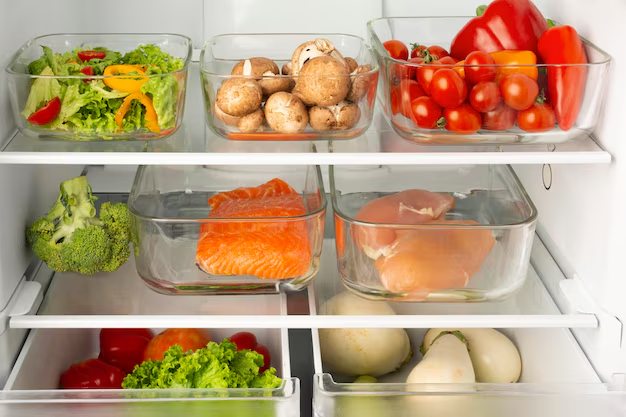Keep Your Broccoli Fresh: The Ultimate Guide to Refrigerator Storage
Broccoli, the vibrant green powerhouse packed with nutrients, has earned its place in kitchens worldwide. Whether you're making a hearty stir-fry, crafting a nutritious salad, or simply enjoying it steamed, ensuring your broccoli stays fresh is key. But have you ever opened your refrigerator to find this superfood looking less than super? You're not alone, and the solution is easier than you think.
Understanding the best ways to store broccoli in the refrigerator can significantly extend its shelf life and preserve its taste and nutritional value. This article will dive into practical strategies, tips, and techniques to ensure your broccoli remains as fresh as the day you bought it.
🥦 Why Freshness Matters
Nutritional Considerations
Broccoli is celebrated for its high vitamin C, fiber, and antioxidant content. Keeping broccoli fresh means preserving these vital nutrients, giving you the maximum health benefits with every bite. When broccoli loses its freshness, not only does it lose flavor and texture, but it also starts diminishing in its nutritional value.
Flavor and Texture
Fresh broccoli has a crisp texture and a slightly sweet flavor that complements many dishes. When stored improperly, it can become mushy and develop an unpleasant taste. Understanding the factors that affect broccoli freshness will help you maintain the best texture and taste.
🛒 From Store to Fridge: Initial Steps to Preserve Freshness
Selecting the Best Broccoli
Your mission to keep broccoli fresh starts at the grocery store. Look for broccoli with tight, compact florets and a deep green color. The stalk should feel firm, not soft. Any yellowing or wilting indicates the produce is past its prime, which can impact how long it stays fresh at home.
Transportation Matters
After selecting the perfect broccoli, the next step is getting it home safely. Keep it separate from items that produce ethylene gas, like apples or bananas, which can speed up ripening and spoilage.
🥦 Storing Broccoli: Techniques and Tips
Proper Refrigeration
Temperature Settings
Broccoli thrives in cold conditions. Aim to store broccoli at approximately 32°F (0°C) to 36°F (2°C) in your vegetable crisper drawer, which provides optimal humidity conditions.
Airflow is Crucial
Allow airflow around the broccoli to keep it from becoming too moist, which can lead to mold. Don't wash it before storage; moisture can speed up decay.
Wrapping Techniques
Loose Produce Bags
Gently wrap your broccoli in a loose produce plastic bag. This method allows broccoli to breathe while keeping it separate from potential contaminants in the fridge.
Paper Towels or Cloth
Wrap broccoli in a dry paper towel or breathable cloth, then place it in the refrigerator. This method absorbs excess moisture and keeps the florets dry.
Avoiding Contamination
Cross-Contamination Awareness
Store broccoli away from raw meats and other contaminants to prevent cross-contamination, ensuring it remains safe to eat.
🌱 Extending Broccoli’s Life: Creative Storage Solutions
Consider Vacuum Sealing
Vacuum sealing can significantly extend the life of your broccoli. By removing air, broccoli stays fresher for longer periods. If you cook meals in bulk or for future purposes, this could be an excellent option.
Freezing Broccoli
Preparation and Blanching
If you have an excess of broccoli, consider freezing it to extend its shelf life. Start by washing and cutting the broccoli into smaller pieces. Blanch the broccoli in boiling water for about three minutes and immediately place it in ice water to halt the cooking process. After drying, place it in airtight freezer bags.
Storage and Use
Frozen broccoli is ideal for cooked dishes and can last several months in the freezer, providing an excellent backup supply for your vegetable needs.
🛠 Troubleshooting: Common Issues and Solutions
Identifying Spoiled Broccoli
Old broccoli will exhibit yellowing florets, a soft texture, or a stronger, disagreeable smell. Cut around minor yellow spots, but discard if the deterioration is widespread.
Dealing with Odor
If broccoli starts to emit a strong odor, it's a sign that it's beginning to spoil. To avoid this, make sure to inspect broccoli regularly and use the techniques outlined above for storage.
Visual Summary: Key Storage Tips
Here's a quick reference to keep your broccoli fresh and flavorful:
- 🛒 Select Wisely: Choose bright green, firm broccoli at the store.
- ❄️ Keep Cool: Store broccoli at 32-36°F in the crisper drawer.
- 🚫 No Moisture: Do not wash before storing; wrap in a dry paper towel.
- 📦 Allow Airflow: Use breathable bags for storage in the fridge.
- 🧊 Freeze When Needed: Blanch and freeze to extend life beyond refrigeration.
- 🧼 Avoid Contaminants: Store away from raw meats and ethylene-producers like apples.
🌿 Beyond Storage: Maximizing Broccoli’s Potential
Culinary Uses
Not only is broccoli versatile, but its culinary uses are vast. Perfect for roasting, steaming, or stir-frying, you're only limited by your culinary creativity.
Preserving Nutrients While Cooking
When preparing broccoli, consider cooking methods that retain its nutrients, like steaming or roasting instead of boiling, which can leach nutrients into the water.
Experimenting with Recipes
Incorporate broccoli into your diet with diverse recipes like soups, casseroles, and smoothies. Exploring new ways to use broccoli can increase your vegetable intake while keeping meals exciting.
Final Insights
By following these strategic steps, you can significantly extend the lifespan of your broccoli, ensuring it remains fresh, flavorful, and full of nutrients. Mindful selection and storage practices not only save you money by reducing waste but also help in maintaining a healthier lifestyle. Knowing how to store broccoli properly empowers you to make the most out of this versatile vegetable, keeping your meals delicious and nutritious. Remember, keeping broccoli fresh isn't just about storage—it’s an investment in flavor and health that pays back with every bite.
